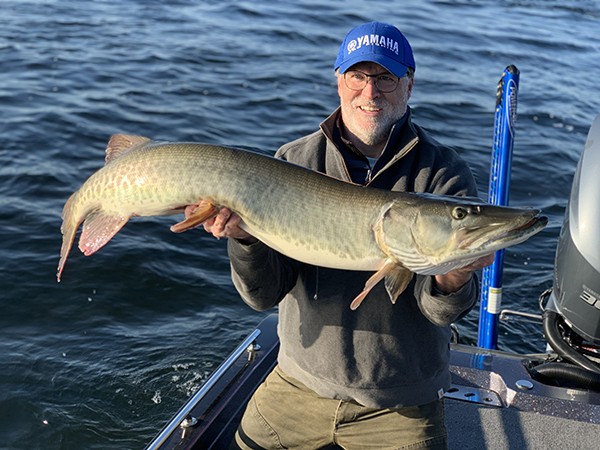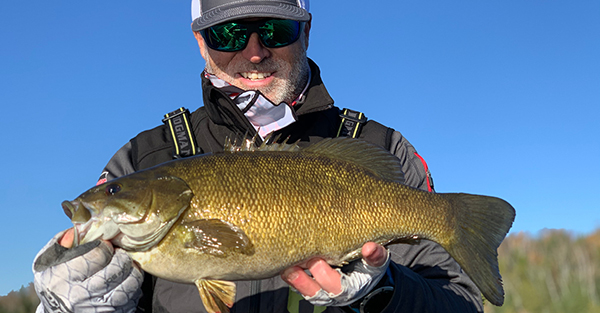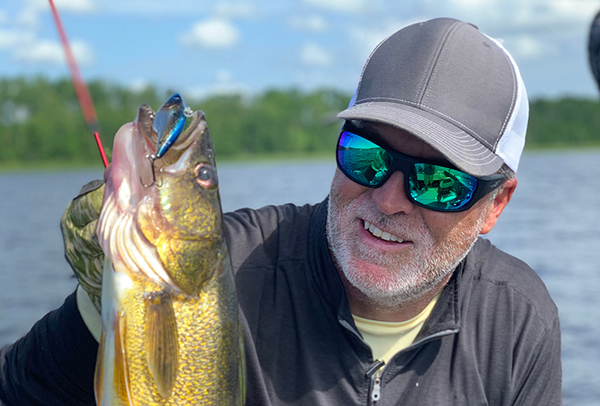As water temperatures drop during the shorter days of autumn, fish react in ways that can baffle anglers. Are they shallow or deep? What role does vegetation play? What structure tends to hold the most fish? Can fall spawning baitfish impact fish location?
One of the things that I love about fall fishing is that it is challenging, but when you solve the daily riddle, you can enjoy some of the best fishing of the year.
So, let’s break down the major factors impacting fish location as fall progresses.
Water Temps
When the sun sets each fall evening, water temps drop quickly, especially in the shallows. Fish like bass usually react by moving deeper, where water temps remain more stable.
In early fall, mid-depth structure can be key. Look for flats, breaks and secondary points in 8 to 12 feet of water. Cranks, rattlebaits and bladed jigs are all great choices for covering water and triggering strikes from a variety of fish species.As fall progresses and water temps continue to drop, start working deeper structure. Main lake points, steep breaks, deep grass and even deep basin areas can all hold fish.

Good electronics allow you to cover a lot of water and find fish. Traditional 2D sonar works very well and side imaging is even more effective for quickly locating fish, rock piles, grass and other fish-holding areas.
My favorite presentation for targeting deep fall bass and walleye is throwing large soft plastic swimbaits. They are easy to fish, even with cold hands, and allow you to effectively cover a variety of water depths.
My favorite bait is beefy 4.6 inches long with a big paddletail that moves well at slower retrieve speeds. I rig the bait on a ½ ounce leadhead jig with a large 3/0 hook when working depths from 10 to 15 feet; and will go up to a ¾- or even 1-ounce jig head when targeting fish holding in 20 to 30 feet of water.
Big paddletails move a lot of water with each tail beat so make sure your jig head is heavy enough to control the bait…even a 1-ounce head rises during the retrieve with these baits.
This is not a finesse presentation. I use 15-pound fluoro and a medium-heavy 7-foot or longer baitcast combo and make long casts. Allow the bait to sink to the bottom, then start a slow, steady retrieve. Add a few pauses each cast to the let the bait fall back to the bottom. This pause often triggers aggressive strikes.

Time of Day
Water temps can change dramatically throughout the day during fall, especially under clear skies. This can make fishing tough, especially for big fish, as their large body mass may have body temps that differ from the water that surrounds them.This also holds true during the spring, particularly in far northern waters where water temps can rise significantly in the shallow, dark-bottom bays sought out by fish like northern pike.
On warmer, clear days, I find the best fishing is usually early in the morning or late in the afternoon after the water temp has stabilized. Cloudy days tend to offer a better bite throughout the day as water (and air) temps are usually more stable.

Vegetation 101
Falling temps during fall usually kills vegetation in shallow areas of a lake or river. Fish abandon areas of dead, decaying vegetation as dissolved oxygen levels drop near them. Top anglers do the same and seek out stands of healthy grass. I use my sonar to search for stands of bright green vegetation. In the lakes I fish most, stands of cabbage weed, milfoil and coontail all hold numbers of fish during the fall, especially bass, crappie and walleye.
Work swimbaits, swim jigs, cranks and spinnerbaits over the top of the grass when searching for active fish. Jigs tipped with plastic or big livebait, drop-shots, Texas-rigged plastics and other options are great for working the deep weed edge.
When you are on fish, pay attention to the type of grass they are using and study your electronics to understand what it looks like on screen. This will help you find other areas with the same grass.

The Forage Factor—Important!
In many waters, particularly southern reservoirs, but true elsewhere, baitfish movement impact the location of bass and other target species.
As water temps begin to drop, shad move onto points and along the edges of creek channels, and so do the bass that feed on them. Small, fast-moving baits like lipless cranks and topwaters can be very effective on shad-gorging bass.
In late fall, bass move deeper into the backs of creeks and coves, sometimes holding in very shallow water if baitfish are present. Watch for signs of bait when on the water…birds working schools or the bait itself.
This is typically not the best time of year for catching numbers of bass, but it is a great time for catching trophy fish.
In northern water, prey species like ciscoes and whitefish, both fall spawners, leave main lake basins and move to shallow spawning areas to spawn in October and November. Large predators like muskie and big pike follow their prey as it moves shallow, making it easier for anglers to target them.
Trolling giant cranks, baits up to 15 inches or longer, is effective on these monsters
in late fall. Look for shallow rock with quick access to deep water and cover water quickly.
Fall Is Special
The key to success during the fall is remembering that this is a time of tremendous change. Pay attention to changes in water temps, baitfish location and grass health, and build your them to build effective daily patterns based on fish location.
Back to Blue Life
One of the things that I love about fall fishing is that it is challenging, but when you solve the daily riddle, you can enjoy some of the best fishing of the year.
So, let’s break down the major factors impacting fish location as fall progresses.
Water Temps
When the sun sets each fall evening, water temps drop quickly, especially in the shallows. Fish like bass usually react by moving deeper, where water temps remain more stable.
In early fall, mid-depth structure can be key. Look for flats, breaks and secondary points in 8 to 12 feet of water. Cranks, rattlebaits and bladed jigs are all great choices for covering water and triggering strikes from a variety of fish species.As fall progresses and water temps continue to drop, start working deeper structure. Main lake points, steep breaks, deep grass and even deep basin areas can all hold fish.

Good electronics allow you to cover a lot of water and find fish. Traditional 2D sonar works very well and side imaging is even more effective for quickly locating fish, rock piles, grass and other fish-holding areas.
My favorite presentation for targeting deep fall bass and walleye is throwing large soft plastic swimbaits. They are easy to fish, even with cold hands, and allow you to effectively cover a variety of water depths.
My favorite bait is beefy 4.6 inches long with a big paddletail that moves well at slower retrieve speeds. I rig the bait on a ½ ounce leadhead jig with a large 3/0 hook when working depths from 10 to 15 feet; and will go up to a ¾- or even 1-ounce jig head when targeting fish holding in 20 to 30 feet of water.
Big paddletails move a lot of water with each tail beat so make sure your jig head is heavy enough to control the bait…even a 1-ounce head rises during the retrieve with these baits.
This is not a finesse presentation. I use 15-pound fluoro and a medium-heavy 7-foot or longer baitcast combo and make long casts. Allow the bait to sink to the bottom, then start a slow, steady retrieve. Add a few pauses each cast to the let the bait fall back to the bottom. This pause often triggers aggressive strikes.

Time of Day
Water temps can change dramatically throughout the day during fall, especially under clear skies. This can make fishing tough, especially for big fish, as their large body mass may have body temps that differ from the water that surrounds them.This also holds true during the spring, particularly in far northern waters where water temps can rise significantly in the shallow, dark-bottom bays sought out by fish like northern pike.
On warmer, clear days, I find the best fishing is usually early in the morning or late in the afternoon after the water temp has stabilized. Cloudy days tend to offer a better bite throughout the day as water (and air) temps are usually more stable.

Vegetation 101
Falling temps during fall usually kills vegetation in shallow areas of a lake or river. Fish abandon areas of dead, decaying vegetation as dissolved oxygen levels drop near them. Top anglers do the same and seek out stands of healthy grass. I use my sonar to search for stands of bright green vegetation. In the lakes I fish most, stands of cabbage weed, milfoil and coontail all hold numbers of fish during the fall, especially bass, crappie and walleye.
Work swimbaits, swim jigs, cranks and spinnerbaits over the top of the grass when searching for active fish. Jigs tipped with plastic or big livebait, drop-shots, Texas-rigged plastics and other options are great for working the deep weed edge.
When you are on fish, pay attention to the type of grass they are using and study your electronics to understand what it looks like on screen. This will help you find other areas with the same grass.

The Forage Factor—Important!
In many waters, particularly southern reservoirs, but true elsewhere, baitfish movement impact the location of bass and other target species.
As water temps begin to drop, shad move onto points and along the edges of creek channels, and so do the bass that feed on them. Small, fast-moving baits like lipless cranks and topwaters can be very effective on shad-gorging bass.
In late fall, bass move deeper into the backs of creeks and coves, sometimes holding in very shallow water if baitfish are present. Watch for signs of bait when on the water…birds working schools or the bait itself.
This is typically not the best time of year for catching numbers of bass, but it is a great time for catching trophy fish.
In northern water, prey species like ciscoes and whitefish, both fall spawners, leave main lake basins and move to shallow spawning areas to spawn in October and November. Large predators like muskie and big pike follow their prey as it moves shallow, making it easier for anglers to target them.
Trolling giant cranks, baits up to 15 inches or longer, is effective on these monsters
in late fall. Look for shallow rock with quick access to deep water and cover water quickly.
Fall Is Special
The key to success during the fall is remembering that this is a time of tremendous change. Pay attention to changes in water temps, baitfish location and grass health, and build your them to build effective daily patterns based on fish location.
Back to Blue Life
